
Wine Culture and Information since 2002 - Volume 22
 Wine Culture and Information since 2002 - Volume 22 |
|
Issue 19, May 2004 |
Contents |
|
|
The New Season of Wine |
|
Springtime has finally come - to tell the truth, springtime arrived some weeks ago - and this period of the year always represents a significative moment for every winery of the northern hemisphere of our planet. In fact it is right in this season that wines produced in recent harvests are being released and in particular white wines and red wines destined to an immediate consumption. The results of the new vintage is always anticipated by the releasing of nouveau wines in November, an event which is not always reliable for assessing the wines produced with “canonical” methods and released for consumption, more or less, with the arrive of springtime. It is not by chance that right in springtime and in the month of November is concentrated the majority of wine fair trades all over the world. This is probably the best period, just like summertime, for appreciating new wines and in particular whites. Like we said so many times, white wines truly suitable for the aging in bottle are very few and most of the times one ends up to uncork a white wine when it lost its best characteristics. This is particularly true for all those whites which have been fermented and aged in inert containers, such as stainless steel or concrete, and therefore purposely created with the explicit aim of offering qualities of freshness and youth. Wines having fresh aromas of flowers and fruits, fragrant and pleasing, capable of giving their best in their best time which certainly is represented by youth. So, is there a better period than this to take advantage of this opportunity? With the coming of warm days it will certainly be pleasurable to have some aromatic and crisp wine in the glass which will certainly make joyous both meals and leisure moments. Moreover, because of the non truly enthusiastic result of vintage 2002, where few areas was capable of giving wines worth of remarkable quality, the curiosity to know and see how the last year will do - the 2003 - will certainly contribute for the preference of the new wines. Premises seem to be certainly promising, ready to deny the non truly good vintage 2002, in which many wineries have even decided not to release their wines, in particular red wines. This certainly is a remarkable behavior which is worth of esteem, first of all for the respect and loyalty these producers shown for their consumers and, last but not the least, even for keeping the prestige and the qualitative level of their best wines. Other wineries, in order not to completely compromise the work of the year 2002, have decided to lowering the class of their best wines, while realizing that year did not contribute to have wines that could worthily represent them, and therefore they decided to sell those wines at lower prices and reclassified with different names or in categories belonging to lower appellations. No matter of what it was, this certainly is an appreciable behavior which shows respect and honesty for their consumers. What about red wines? The wines to be drunk young and aged for few months are usually released for consumption with the arrive of springtime, just like for whites, whereas for appreciating reserves - including the ones of the year 2002 - it is to be waited one more month - June usually represents the releasing of such wines - or probably the end of summertime and the beginning of autumn. In other words, full bodied and alcoholic wines which announce the end of the warm season and welcome the cold one, or better to say, less torrid. However the arrive of the warm season - announced by the arrive of springtime - is happily accompanied by those young and light red wines, which are well suitable for the service at more summertime and cool temperatures. Even rose wines find in the warm season their best moment: released for the consumption with the arrive of springtime, they are happily appreciable at cool temperatures and therefore extremely pleasing - aromatic and agreeable - in this moment of thoughtless youth. The end of wintertime and the beginning of the mild season is also the moment in which takes place the last phase of the production of classic method sparkling wines: disgorgement. After a short and proper period of aging which follows the adding of the so called liqueur d'expédition - or dosage - classic method sparkling wines are ready to meet - as well as pleasing - the hot days of summertime. What is better than a nice glass of classic method sparkling wine, cool, crisp, pleasing and joyous, to please a good summertime meal or leisure moments spent to the shadow of the heat of sun? Of course sparkling wines produced with the Charmat method are not to be forgotten, these wines are widely used, not only drunk alone, but also as a base ingredient for the hundreds blended drinks in which both wine and sparkling wines represent a fundamental component. Moreover it is right during warm seasons which is particularly liked the aperitif, a drink which finds in sparkling wines - both classic method and Charmat - excellent and good allies. However the too much frequent habit of serving sparkling wines as aperitifs should not be exaggerated because at the end this could make people believe - and this is probably happened already - this is their main role and it certainly is not like that. It must not be forgotten their brilliant role in the table for the matching of a meal, something that sparkling wines can do magnificently well. In short, there is enough to meet every taste and every occasion. The arrive of the warm season always finds every year the lovers of the beverage of Bacchus with a glass in the hand and a providential corkscrew in the other, ready to enjoy the results of the new vintage. We certainly wish the 2003, in which many hope and believe to be a good one, will be capable to let us forget the 2002, which certainly was not rich and generous like the 2001 but it was however capable of giving some, and certainly not many, remarkable bottles. Like always the verdict will be the one expressed by the judgment and the test of the glass, sometimes harsh and however inevitable, with the hope that the 2003 will be capable of giving us new and brilliant emotions. It is however important to remember that behind, or better to say, inside every bottle of wine there are the efforts and passions of men and women who believe in their job and in the dream of making the millenary beverage of Bacchus, who try every year to produce the best they can in the respect of what nature, in everything and for everything, was capable to offer them year after year.
|
||||
MailBox |
|
In this column are published our reader's mail. If you have any comment or any
question or just want to express your opinion about wine, send your letters to
our editorial or fill in
the form available at
our site.
|
| I frequently go for picnics and and I usually like to bring some bottles of wines for the meal. I noticed that after 3 or 4 hours of traveling in the car, the taste of wine gets worse. I understand that in some aged red wines the presence of the sediment in suspension affects taste, however I noticed that after some hours of traveling by car the taste of both young wines and aged wines are different and worse. Why? |
| Hyun Suk Kim -- Pusan (South Korea) |
| Like you rightly observed, transporting aged wines, because of the effects of shaking, has as a consequence the suspension of sediments produced after some years of aging. The suspension of sediments, besides worsening the appearance of wine by making it turbid, also affects the sensorial perception of its organoleptic qualities, in particular the ones of tactile nature. This problem, like everyone knows, can be easily solved by allowing the wine to rest in order to have sediments to deposit on the bottom and therefore they can be separated by a proper decanting. indeed the problem which cause the change of the organoleptic qualities in a wine because of transportation is mainly because of the temperature variations to which the bottle is subjected to. In a car the temperature is usually higher than the ones generally acceptable both for the service and for the keeping of wine. If it is true that four hours spent in a car do not irremediably compromise the keeping and the integrity of a wine, this is however enough to change the sensorial perception both of aromas and taste. In case it is necessary to transport bottles of wine to be consumed after the end of the journey it is good to make use of a thermal container - just like the ones used for picnics - capable of keeping the wine at a constant service temperature and - in case of need - with the help of ice bags or cooling elements. |
| The adding of sugar and yeast in wines for the production of classic method sparkling wine, in order to start the refermentation in bottle, besides producing carbon dioxide, contributes to the increasing of alcohol as well? |
| Antonino Raimondo -- Cislago, Varese (Italy) |
| Base wines used for the production of classic method sparkling wines are made according to the chemical and organoleptic changes which take place during the process of the making of a sparkling wine. The base wine - called cuvée which can also be represented by the blending of many wines and according to the disciplinary or the tradition of the place where the sparkling wine is being produced - must have a pretty high quantity of acid and a low percentage of alcohol. The high quantity of acid is needed for the balance of the sparkling wine when at the end of the process is added the dosage - or liqueur d'expédition - made of variable quantities of sugar and other ingredients. To the base wine is added the so called liqueur de tirage, a blend of sugar, base wine and yeast, in order to start the production of foam and the so called prise de mousse. During this phase, yeasts start a second fermentation, thanks to the presence of sugar, whose main goal is the production of carbon dioxide - responsible for the bubbles in sparkling wines - and alcohol which will raise the alcoholic percentage in the wine. The increasing of alcoholic percentage during the refermentation in bottle is generally equal to some units and this is considered as a side effect of the classic method, as the main goal is the production of carbon dioxide to be solubilized in the wine. |
BurgundyClass and elegance are joined to the magic of white and red wines of the land of Burgundy, the renowned French region indisputable homeland of Chardonnay and Pinot Noir grapes |
|
Among the wine areas of the world, the one which is most frequently mentioned for the elegance and the class of its wines certainly is Burgundy. In this region, thanks to the characteristics of the soil and to the favorable climate, are being produced among the most elegant white wines with Chardonnay and red wines with Pinot Noir, which have been always considered as reference models for the other wine areas where are being produced wines with the same grapes. Burgundy, which is located in the central-eastern part of France, is also one of the most northern place of the world where red wines are produced. The two main grapes cultivated in this region - as well as practically being the only ones - are Chardonnay and Pinot Noir, and both varieties give the best results in cool climates, just like the one of Burgundy, and it is not by chance the wines produced in this region are elegant and refined like few others. Despite Burgundy is considered among the best wine regions of the world - and it certainly is - its geographic and environmental position do not always offer conditions in order to make memorable wines. In vintages where the climate and meteorological conditions are not favorable, when grapes do not reach full ripeness, wines are less aromatic and less complex, less bodied and with weaker and lighter flavors. The happening of less favorable vintages, as well as the best ones and even exceptional ones, makes Burgundy a special and complex region in which, probably more than any other else, it is possible to clearly notice and understand the differences and qualities among vintages. Burgundy is among the most complex and exciting wine regions of the world where the seasonal conditions of the climate is just one of the many factors regulating the production of its magnificent wines.
Burgundy represents, as a matter of fact, a particular case even in France. Burgundy is the land of domaine which are not to be confused with the typical concept of the renowned Bordeaux's château. In Bordeaux, a château is a single property made of vineyards generally located near or around a building - the château - in which are done the many enological practices for the production of wines. On the other hand, the Burgundian domaine is a group of vineyards, most of the times made of tiny areas, located in many areas inside the same territory and even distant many kilometers one from each other and belonging to different appellations. These vineyards are property of an unique entity and the grapes harvested in every vineyard are separately vinified in order to make wines, sometimes is small quantities, capable of expressing the characteristics of every single area. In other words, in Burgundy the terroir is a fundamental concept in the production of wines and here, like in no other part of the world, the respect of the characteristics and the differences of every vineyard is an essential condition for Burgundian enology. Wines produced in Burgundy cannot simply be considered for the specific characteristics of the grapes used - Chardonnay and Pinot Noir - indeed it is the area and the vineyard which mostly express the quality of wines. Whether Burgundian enology has now become important thanks to the concept of the differences among the many places, the merit certainly goes to the meticulous and precious work done by Benedictine and Cistercian monks in the Middle Age. The monks studied the characteristics of the wines produced in the many vineyards and in the many places while setting the borders of what are still now considered the typical Burgundian climat, small vineyards whose characteristics are strongly influenced by the local microclimate and soil conditions. The grapes mainly cultivated in Burgundy are Chardonnay and Pinot Noir, as well as Aligoté - a white berried grape mainly used in Mâconnais for the production of bulk wines and sometimes present in Crémant de Bourgogne sparkling wines - and Gamay, the renowned red berried grape used for the production of wines in Beaujolais.
|
||||||||
|
The classification system for Burgundian wines is made of categories and it is based on specific criteria and indications which are not used in other French regions. The area in which the classification system is used the most is the Côte d'Or in which are used four different categories. The two lowest categories of the system are Bourgogne Rouge and Bourgogne Blanc, respectively for red and white wines, generally produced with grapes from different villages and frequently blends of wines produced in different parts of the region. The first important appellation is Village which is uniquely reserved for wines produced in one specific village, or near to it, among the many recognized by the system. Wines belonging to this category always have in the label the name of the village. Examples of Burgundian villages are Aloxe-Corton, Beaune, Chambolle-Musigny, Chassagne-Montrachet, Flagey-Echézeaux, Gevrey-Chambertin, Meursault, Nuits-St.-Georges, Pommard, Puligny-Montrachet, Volnay, Vosne-Romanée and Vougeot. As already mentioned above, in Burgundy the qualitative differences of wines are strongly influenced by every vineyard and it is not by chance that the two highest categories of the quality system are exclusively reserved to the identification of vineyards. The first category used for the denomination of vineyards is Premier Cru, currently reserved for 562 Burgundian vineyards and which represent about 11% of the total production of this region. The name of the vineyard is written in the label right after the name of the village to which belongs to. The highest category of the system is Grand Cru which is currently reserved to just 33 vineyards and which represent just 2% of total production in Burgundy. Grand Cru vineyards are so celebrated and renowned that in the label is not written the name of the village where they are located but only the name of the vineyard. Examples of Grand Cru are Bâtard-Montrachet, Bonnes Mares, Chapelle-Chambertin, Clos de Vougeot, Corton-Charlemagne, Echézeaux, Griotte-Chambertin, La Romanée, La Tâche, Le Montrachet and Richebourg.
|
||||
|
The region of Chablis is located about 180 kilometers south from Paris (about 110 miles) and about 100 kilometers north from the main region of Burgundy (about 60 miles), whereas the renowned region of Champagne is just 40 kilometers away (25 miles). In the region of Chablis are exclusively produced white wines with Chardonnay grape and the wines of this region are usually considered as a reference model in other countries of the world. Thanks to the region's climate - moist, cool and rigid - as well as to the characteristics of the soil - limestone and clay - Chablis wines are frequently characterized by mineral and fresh aromas as well as pleasing hints of flint. Wines of Chablis are generally fermented in steel tanks - rarely in pretty neutral wood containers - therefore in these wines are never found strong aromas of vanilla and toasted wood which are usually found in international style Chardonnays. However there are some producers who prefer using the cask for their best Grand Cru convinced that the quality of these wines can benefit from the complexity of wood. Chablis wines are classified according to the following categories, from the lower to the higher: Petit Chablis, Chablis, Chablis Premier Cru and Chablis Grand Cru. Vineyards belonging to the category Premier Cru are 40, whereas the ones belonging to Grand Cru are seven and precisely Blanchots, Bougros, Grenouilles, Les Clos, Les Preuses, Valmur and Vaudésir.
|
|
Côte d'Or certainly is the region which represents Burgundy more than any other else and right here are being produced the most famous and representative wines of the region. Côte d'Or is located in the northern part of the region and it is traditionally divided into two distinct subregions: in the northern part is located Côte de Nuits whereas in the southern part there is Côte de Beaune. Côte d'Or goes from the city of Dijon to the city of Santenay for an overall distance of about 50 kilometers (about 31 miles) and its soil is mainly limestone. All Burgundian wines classified as Premier Cru and Grand Cru are being produced in Côte d'Or.
|
|
Côte de Nuits is the northern part of Côte d'Or and it is considered as the great Burgundian land of red wines made from Pinot Noir. Despite the area is identified with its valuable and excellent red wines, in Côte de Nuits is also produced a pretty small quantity of white wines with Chardonnay, Pinot Blanc and Pinot Gris grapes. Just like all other areas of Burgundy, Côte de Nuits is divided in villages, each one of them belonging to specific appellations, and among the most important ones are to be mentioned Chambolle-Musigny, Fixin, Gevrey-Chambertin, Marsannay, Morey-Saint-Denis, Nuits-Saint-Georges, Vosne-Romanée and Vougeot. Côte de Nuits is mainly associated to the quality of its red wines - certainly among the best in the world - all belonging to the Premier Cru and Grand Cru categories. Among the renowned Grand Cru should be mentioned Bonnes Mares, Chambertin, Chambertin-Clos de Bèze, Clos de Roche, Clos de Vougeot, Grands Echézeaux, Musigny, Richebourg, Romanée-Conti and La Tâche. In Côte de Nuits are also found the Côte de Nuits Villages and Hautes-Côtes de Nuits appellations. Wines from Côte de Nuits Villages generally are of good quality - sometimes even excellent - whereas in Hautes-Côtes de Nuits, because of a higher altitude, grapes sometimes do not reach full ripeness and therefore wines from this area are usually considered of less value than the ones from Côte de Nuits.
|
|
Côte de Beaune identifies the southern part of Côte d'Or in which are produced both white wines and red wines, however this area is mainly identified for its white wines produced with Chardonnay grape, certainly among the best whites of Burgundy and among the best of the world. No matter the production of red wines in Côte de Beaune is remarkable - in particular the ones produced at Corton - these wines are less famous because of the greatness of its white wines and for the excellence of red wines produced in the neighboring Côte de Nuits. Côte de Beaune is divided into villages, each of them belonging to its specific appellation, of which are to be mentioned Aloxe-Corton, Auxey-Duresses, Beaune, Blagny, Chassagne-Montrachet, Chorey-Lès-Beaune, Landoix-Serrigny, Meursault, Monthélie, Pernand-Vergelesses, Pommard, Puligny-Montrachet, Saint-Aubin, Saint-Romain, Santenay, Savigny-Lès-Beaune and Volnay. Among the Grand Cru of Côte de Beaune are to be mentioned Montrachet, Bâtard-Montrachet, Bienvenue-Bâtard-Montrachet, Chevalier-Montrachet, Corton-Charlemagne and Criots-Bâtard-Montrachet. In this area are also found the Côte de Beaune Villages and Hautes-Côte de Beaune appellations. Wines from Côte de Beaune Villages are usually produced with blends of wines coming from the villages of this area, whereas in Hautes-Côtes de Beaune, because of the higher altitude and a lesser exposition to sun rays, grapes sometimes do not reach full ripeness and wines usually have a lesser value.
|
|
This area is located south from the Côte d'Or and here are produced both red and white wines. The area is mainly known for the wines produced in its main villages: Bouzeron, Givry, Mercurey, Montagny and Rully. In this area are not found any Grand Cru, however there are many Premier Cru. Despite the quality of the wines of Côte Chalonnaise is considered lower than the ones of the more renowned Côte d'Or, here are however produced good white and red wines. The most famous village is Mercurey in which are produced good red wines with Pinot Noir as well as a small quantity of white wines. In the village of Bouzeron, in the northern part of this area, are being produced white wines with Aligoté grape, certainly the best French wines produced with this grape. In the village of Givry are produced both white and red wines, however the red wines are the ones which mainly characterize this area. In Montagny, the most southern village of Côte Chalonnaise, are exclusively produced white wines with Chardonnay of interesting quality. The village of Rully is famous for the production of classic method sparkling wines known as Crémant de Bourgogne - mainly produced with Aligoté grape and in lesser part with Pinot Noir, Chardonnay, Pinot Blanc and Pinot Gris - however in this area are also produced white and red wines.
|
|
South from Côte Chalonnaise is located the large area of Mâconnais. This area is mainly oriented to the production of white wines - usually having an average quality and destined for a bulk consumption - and here are not found any Premier Cru or Grand Cru. The best Mâconnais wines, which in terms of quality are different from the rest, are Mâcon, Pouilly-Fuissé and Saint-Véran, white wines produced with Chardonnay. A curiosity of Mâconnais is represented by the small village called Chardonnay - just like the renowned white berried grape - and of which it is not certain whether it is the place where this grape has its origin, and therefore the grape was called with the name of the village, or the village was named like that in honor of the main grape of Burgundy.
|
|
The most southern area of Burgundy is Beaujolais and practically this area does not have anything in common with all the other Burgundian regions although it is part of it. Climate is different, the method used for the production of wine is different and the grapes are different. Whether the rest of Burgundy is identifiable with Chardonnay and Pinot Noir grapes, Beaujolais is the homeland of Gamay. The region of Beaujolais is also famous for its young and joyous Beaujolais Nouveau, the renowned “new wine”, which has now become so famous in the world and shadowed the other and main wines of this area. In this region are almost exclusively produced red wines, however there is also a small production of white wines made from Chardonnay and Aligoté grapes. Beaujolais wines are classified in three categories of quality, from the lower to the higher: Beaujolais, Beaujolais-Villages and Beaujolais Cru. As opposed to the other French areas, in Beaujolais the term cru is not used for identifying specific vineyards but it is used for the definition of one of the ten villages considered to be the best of the area. The ten cru villages of Beaujolais are: Brouilly, Chénas, Chiroubles, Côte de Brouilly, Fleurie, Juliénas, Morgon, Moulin-à-Vent, Régnié and Saint-Amour.
|
Cabernet SauvignonNow spread in every wine producing country of the world, Cabernet Sauvignon has always been charming for its full bodied and elegant wines that from Bordeaux have conquered the world |
|
Cabernet Sauvignon is one of those grapes which are often subject of conversations among wine lovers, so famous and celebrated that even the most neophyte of the beverage of Bacchus lovers has heard of it at least once and, highly probable, has also tasted at least one wine in which it was present. Usually associated to great wines - elegant and important - Cabernet Sauvignon is particularly remembered for the body and structure of its wines, as well as for its charming aromas and strong flavors. Cabernet Sauvignon, from its homeland, which is identified with good certainty in the Bordeaux region, is now and practically present in every country of the world where wine is being produced and it also belongs to the argued group - in good and bad sense - of the so called international grapes. Cabernet Sauvignon is so spread in the world that, alone and frequently together with Merlot, is used in blends together with the local grapes of the countries where it is cultivated, however it is often vinified alone as well. The origins of this grape have been for many centuries uncertain and not very clear. Reliable information about Cabernet Sauvignon suggest that the first area in which this grape was intensively and extensively cultivated was the region of Bordeaux, that is the region that still today is considered as its preferred land and, in particular, the Médoc. Historical evidences tell that the grape began to concretely spread in the Bordeaux area around the end of the eighteenth century. Studies about the classification and the description of Cabernet Sauvignon have convinced researchers this grape probably is the famous Biturica vine, praised and described by Pliny the Elder in his monumental work Naturalis Historia. The name Biturica derives from the Biturigi people that at those times lived in the northern part of the Pyrenees. Recent researches done at the University of Bordeaux about the genetic characteristics of Cabernet Sauvignon have allowed to solve its origin - surprising, amazing and exciting - and it seems this grape was a spontaneous crossing between Cabernet Franc and Sauvignon Blanc, from which it also took part of their names to form its own name.
The spreading of Cabernet Sauvignon in the world is so wide that often it is simply defined as “Cabernet”. The use of this abbreviation, to tell the truth, too much abused, has been the origin of some misunderstandings and confusions in the proper identification of the wines produced with this grape. Whether it is true that most of the times the use of the term “Cabernet” is referred to Cabernet Sauvignon, it is also true that in some areas, when this term is used, they usually refer to Cabernet Franc. Moreover in some wines produced in the north-eastern part of Italy - in particular in Veneto and Friuli Venezia Giulia - it is pretty frequent to find in labels of bottles the definition “Cabernet” only and this is usually referred to a wine made from both Cabernet Franc and Cabernet Sauvignon of which, highly probable, it is Cabernet Franc to represent the higher percentage. Cabernet Sauvignon is a grape capable of producing wines from pretty ordinary to extremely and magnificently elegant and refined, in which are clearly expressed, something that always happens for any other grape, the typicality of the territory, and more concretely, the cultural practices and the vinification techniques used for the production. Cabernet Sauvignon bears bunches with pretty small berries and with thick skin, rich in colorant substances and tannins, with a pretty high ratio to the juice. Thanks to this characteristic, the wines produced with this grape, provided it was properly cultivated, are always pretty robust and tannic, a condition which often - and traditionally - favors the adding of Merlot in order to smooth and soften the finished product. Cabernet Sauvignon is a late ripening grape and therefore is cultivated with good results and preferably in warm climate areas. The most frequent vinification practice of Cabernet Sauvignon makes use of casks - and more specifically barrique - which contributes both to smooth the strong astringency - by adding softer and sweeter wood tannins - and to give olfactory and gustatory organoleptic qualities of high agreeability. The longevity of wines made from Cabernet Sauvignon is pretty variable and it strongly depends on how the grape was cultivated and vinified. The acidity of Cabernet Sauvignon is pretty high and this characteristic, as well as the high quantity of tannins, allows its wines to remarkable period of aging. The longevity of Cabernet Sauvignon can range from 3 or 4 years - in case it was cultivated with high yields and vinified in an ordinary way - up to more than 20 years in case it was cultivated with low yields and vinified according to quality criteria. Because of its late ripening, this grape is not suitable in pretty cold climate areas. The aromatic range of Cabernet Sauvignon is strongly influenced both by the area and the type of soil in which it was cultivated and the level of ripeness at the time of harvesting. The aromatic characteristic that more than any other else distinguishes this grape is the aroma of black currant, a quality which is practically found in every Cabernet Sauvignon cultivated in every place of the world. When this grape is being harvested underripe or not completely ripe, the aromatic qualities are strongly characterized by evident aromas of vegetal and herbaceous substances which are directly associated to the ones of Cabernet Franc. Cabernet Sauvignon, just like Merlot, has a so high reputation and esteem among wine lovers and wine makers that it is frequently used in wines with the explicit goal - and hope - to improve a modest product in order to make it more “elegant” and “important”. Whether it is true that by using Cabernet Sauvignon can be frequently achieved such results, it must be remembered - always and however - that the presence of this grape in a wine, or of any other else, does not represent a guarantee of quality. Cabernet Sauvignon cultivated with high yields makes pretty ordinary and mediocre wines, just like any other grape, therefore it is necessary to consider it with proper distinctions - in particular when “famous” international grapes are used in the blend - between real quality and plain speculation.
|
||||||||
|
Cabernet Sauvignon has a skin which is generally rich in colorant substances therefore - according to the area in which the grape was cultivated, the level of ripeness at the time of harvesting and cultural yields - wines produced with this grape show pretty intense colors. Because of its colorant capacity, wines produced with Cabernet Sauvignon cultivated with qualitatively acceptable practices, have a pretty low transparency and sometimes they are almost impenetrable to light. During youth - a period that for quality Cabernet Sauvignon wines can also last many years - color gets intense and deep ruby red hues with evident purple red nuances. The evolution of the color of Cabernet Sauvignon - capable of producing wines of remarkable longevity - is pretty slow and quality wines tend to get to garnet red colors after many years, sometimes even more than ten years. In wines produced with pretty low quality criteria - first of all excessive cultural yields - transparency will be pretty high and the evolution of the color will follow a pretty quick cycle and after three or four years it will be turned into a garnet red color.
|
|
The aromatic qualities of Cabernet Sauvignon are generally well identifiable thanks to the presence of strong and clean aromas of black berried fruits where the most recognizable ones are black currant and black cherry. Wines produced with Cabernet Sauvignon are generally fermented and aged in cask therefore also aromas of vanilla and toasted wood - sometimes cedar wood or cigar box - will be present with more or less accentuated intensities. Grapes cultivated in cool climate areas, or harvested when they did not reach full ripeness, produce wines with evident herbaceous and vegetal aromas, such as tomato leaf, bell pepper, olive and bruised black currant leaf, as well as aromas of black berried fruits, such as black cherry, black currant, blueberry and plum. In grapes cultivated in warm climate areas or however harvested at full ripeness, aromas of the herbaceous and vegetal families tend to disappear - most of the times completely - and pleasing and intense aromas of fruits, in particular black currant, black cherry, plum and blueberry can be perceived, sometimes also as jams, and it is usual to find an aroma of violet as well. In wines produced with Cabernet Sauvignon are frequent aromas of licorice and tobacco, as well as other unmistakable aromas passed from wood during the aging period, such as vanilla, cigar box, coffee and cedar wood. Balsamic aromas are also frequent of which the most common ones are eucalyptus and menthol. With times the aromas of Cabernet Sauvignon - also thanks to its excellent longevity - follow an interesting evolution and aromas of fruit are transformed into rich jams, moreover aromas of cocoa, chocolate and leather can be perceived as well, and with some more aging, balsamic aromas get more intense whereas elegant aromas of underbrush and mushrooms begin to develop. In wines produced with Cabernet Sauvignon is also common to find aromas of spices such as cinnamon, clover, nutmeg, rhubarb, black pepper and cinchona.
|
||||
|
Cabernet Sauvignon is characterized by a high quantity of polyphenolic substances - tannins - and a pretty high acidity which are both found in the taste of its wines. The skin of this grape is pretty thick and therefore the juice will be rich in solid substances capable of producing full bodied wines with robust structures and pretty high extracts. Wines produced with Cabernet Sauvignon are generally pretty alcoholic - from moderate to high - an essential requisite in order to balance the strong astringency produced by tannins. In wines produced with quality standards - low yields and right wine making practices - the main characteristics will be represented by a robust structure and appreciable astringency, as well as a pretty high percentage of alcohol. In low quality wines, the astringency will be lower and the percentage of alcohol will be lesser and in these cases wines are pretty ordinary and common. The astringency and the robust structure of Cabernet Sauvignon are usually the result of precise productive choices in order to make wines suitable for long aging periods in bottle.
|
|
Cabernet Sauvignon is considered among the most known and spread international grapes and it is practically present in all the wine producing countries of the world. Its homeland is however the Bordeaux region - in particular the Médoc and the Graves - where the wines produced with this grape, besides being characterized by elegance and finesse, are considered as the reference model all over the world. In these areas, where gravelly soils keep the heat capable of favoring ripeness, Cabernet Sauvignon is practically present in every wine together with Merlot and Cabernet Franc, its most renowned allies in this region. Wines from Saint-Estèphe are characterized by strong aromas of fruit and good body, whereas in Pauillac, with its gravelly soils, Cabernet Sauvignon wines have robust structures. The less gravelly soil in Saint-Julien produces less tannic Cabernet Sauvignons than Pauillac, whereas in Margaux wines have a higher elegance and finesse. In the Graves this grape produces very interesting wines characterized by aromas of fruit and sometimes “earthy” as well. Other French areas in which Cabernet Sauvignon is cultivated are the Loire Valley, South-West, Languedoc and Provence. Outside the French borders Cabernet Sauvignon is present everywhere. In Italy is frequently used together with the typical grapes of the many regions and it can also be found vinified alone. In Spain Cabernet Sauvignon is present in modest quantities and with appreciable results. In Europe this grape is also present in Austria, Greece, Bulgaria and Hungary. In the rest of the world - that is in those countries considered as the “New World” - Cabernet Sauvignon has now a strong and solid presence. The grape is very common in California and in particular in Napa Valley where are being produced excellent wines with this grape. Even the neighboring Washington state produces Cabernet Sauvignon of remarkable quality and certainly to be considered among the best ones of the country. In South America Cabernet Sauvignon is present in Chile - in particular in Maipo Valley - and in Argentina, at Mendoza. Australia produces different styles of Cabernet Sauvignon where Coonawarra is probably the most representative region. The cool climate of New Zealand produces interesting Cabernet Sauvignons, with herbaceous tastes and aromas which are frequently mitigated by Merlot. In South Africa this grape is often used together with other grapes, however here can be found good examples of wines exclusively produced with Cabernet Sauvignon.
|
Wines of the Month |
|
|
|
Score legend Prices are to be considered as indicative. Prices may vary according to the country or the shop where wines are bought |
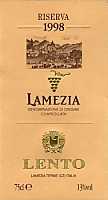
|
|
Lamezia Rosso Riserva 1998 |
|
| Cantine Lento (Italy) | |
| Grapes: Magliocco (35%), Greco Nero (35%), Nerello (30%) | |
| Price: € 11,00 | Score: |
| The wine shows a brilliant ruby red color and nuances of garnet red, moderate transparency. The nose reveals intense, clean, pleasing and refined aromas which start with hints of black cherry jam and cherry followed by aromas of raspberry, dried plum, dried violet, licorice, tobacco, cocoa, vanilla and hints of menthol. In the mouth has good correspondence to the nose, a slightly tannic attack and however balanced by alcohol, good body, intense, flavors, good tannins, agreeable. The finish is persistent with flavors of plum and black cherry jam. This wine ages in barrique for 12 months and for 6 months in bottle. | |
| Food Match: Roasted meat, Hard cheese, Stewed meat | |
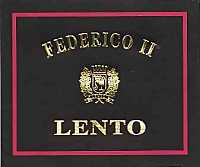
|
|
Federico II 2001 |
|
| Cantine Lento (Italy) | |
| Grapes: Cabernet Sauvignon | |
| Price: € 11,00 | Score: |
| The wine shows a brilliant ruby red color and nuances of ruby red, little transparency. The nose reveals intense, clean, pleasing and elegant aromas that start with hints of black cherry and plum followed by aromas of raspberry, blackberry, licorice, black currant, dried violet, vanilla and hints of tobacco, eucalyptus and cocoa. In the mouth has good correspondence to the nose, a slightly tannic attack and however balanced by alcohol, full body, intense flavors, good tannins. The finish is persistent with flavors of plum and black cherry. A well made wine. Federico II ages for 12 months in barrique followed by 6 months of aging in bottle. | |
| Food Match: Game, Roasted meat, Braised and stewed meat, Hard cheese | |
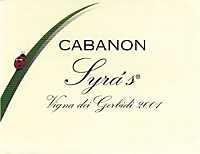
|
|
Syra's Vigna dei Gerbidi 2001 |
|
| Fattoria Cabanon (Italy) | |
| Grapes: Syrah | |
| Price: € 17,50 | Score: |
| This wine shows an intense ruby red color and nuances of ruby red, little transparency. The nose denotes intense, clean, pleasing and refined aromas which start with hints of black cherry and plum followed by aromas of blueberry, blackberry, tobacco, licorice, vanilla and hints of black pepper. In the mouth has good correspondence to the nose, a slightly tannic attack and however balanced by alcohol, good body, intense flavors, good tannins. The finish is persistent with flavors of plum and black cherry. This wine ages for 6 months in barrique. | |
| Food Match: Stuffed pasta with mushrooms, Roasted meat, Stewed meat with mushrooms | |
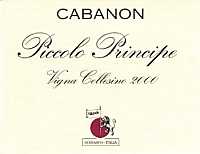
|
|
Oltrepò Pavese Rosso Piccolo Principe Vigna Collesino 2001 |
|
| Fattoria Cabanon (Italy) | |
| Grapes: Barbera | |
| Price: € 22,00 | Score: |
| This wine shows an intense ruby red color and nuances of ruby red, little transparency. The nose reveals good personality with intense, clean, pleasing, elegant and refined aromas which start with hints of black cherry and plum followed by good aromas of blueberry jam, black currant, violet, tobacco, licorice, vanilla, chocolate and hints of cinnamon and clover. In the mouth has very good correspondence to the nose, a slightly tannic attack and a pleasing crispness, however well balanced by alcohol, full body, intense flavors, good tannins, agreeable. The finish is persistent with good flavors of blueberry jam, plum and black cherry. Piccolo Principe ages for 12 months in barrique. | |
| Food Match: Braised and stewed meat, Roasted meat, Hard cheese | |
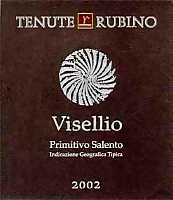
|
|
Visellio 2002 |
|
| Tenute Rubino (Italy) | |
| Grapes: Primitivo | |
| Price: € 15,00 | Score: |
| The wine shows a deep ruby red color and nuances of ruby red, little transparency. The nose reveals good personality with intense, clean, pleasing, refined and elegant aromas which start with hints of black cherry, blueberry and blackberry followed by aromas of plum, violet, tobacco, licorice, vanilla and hints of chocolate and eucalyptus. In the mouth has good correspondence to the nose, a slightly tannic attack and however balanced by alcohol, full body, intense flavors, good tannins. The finish is persistent with flavors of black cherry, plum and blackberry. A well made wine. Visellio ages for 8 months in barrique. | |
| Food Match: Braised and stewed meat, Roasted meat, Game, Hard cheese | |
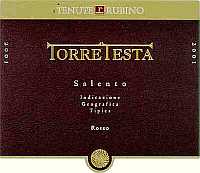
|
|
Torre Testa 2001 |
|
| Tenute Rubino (Italy) | |
| Grapes: Susumaniello | |
| Price: € 15,00 | Score: |
| This wine shows a deep ruby red color and nuances of ruby red, little transparency. The nose reveals good personality with intense, clean, pleasing, refined and elegant aromas which start with hints of black cherry and blackberry followed by good aromas of blueberry, plum, black currant, tobacco, violet, licorice, vanilla and hints of chocolate and menthol. In the mouth has good correspondence to the nose, a slightly tannic attack and however balanced by alcohol, full body, intense flavors, good tannins, agreeable. The finish is very persistent with flavors of blackberry, plum and black cherry. A well made wine. Torre Testa ages for 14 months in barrique. | |
| Food Match: Roasted meat, Braised and stewed meat, Game, Hard cheese | |

|
|
Friuli Isonzo Tocai Friulano 2002 |
|
| Borgo San Daniele (Italy) | |
| Grapes: Tocai Friulano | |
| Price: € 15,00 | Score: |
| The wine shows a pale straw yellow color and nuances of greenish yellow, very transparent. The nose reveals intense, clean, pleasing and refined aromas which start with hints of almond, plum and hawthorn followed by aromas of yeast, apple, pear, grapefruit and hints of mineral. In the mouth has good correspondence to the nose, a crisp attack and however well balanced by alcohol, good body, intense flavors, agreeable. The finish is persistent with flavors of plum, pear and almond. | |
| Food Match: Fish appetizers, Pasta and risotto with fish and crustaceans, Fried fish | |

|
|
Friuli Isonzo Arbis Blanc 2002 |
|
| Borgo San Daniele (Italy) | |
| Grapes: Sauvignon Blanc (40%), Chardonnay (40%), Tocai Friulano (20%), Pinot Blanc (20%) | |
| Price: € 16,00 | Score: |
| The wine shows a brilliant straw yellow color and nuances of greenish yellow, very transparent. The nose reveals good personality with intense, clean, pleasing, refined and elegant aromas which start with hints of peach and litchi followed by good aromas of acacia, pineapple, banana, hawthorn, broom, almond, grapefruit and hints of elder and mineral. In the mouth has good correspondence to the nose, a crisp attack and pleasing roundness, well balanced by alcohol, good body, intense flavors, agreeable. The finish is persistent with flavors of peach, litchi and pear. A well made wine. | |
| Food Match: Fish soups, Pasta and risotto with fish and crustaceans, Broiled fish | |
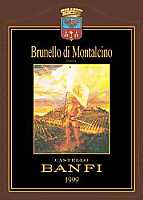
|
|
Brunello di Montalcino 1999 |
|
| Castello Banfi (Italy) | |
| Grapes: Sangiovese Grosso | |
| Price: € 32,00 | Score: |
| The wine shows a deep ruby red color and nuances of garnet red, little transparency. The nose reveals intense, clean, pleasing, refined and elegant aromas which start with good hints of black cherry and plum followed by aromas of blackberry, blueberry, licorice, tobacco, cinnamon, vanilla and hints of eucalyptus. In the mouth has good correspondence to the nose, a tannic attack and however balanced by alcohol, full body, intense flavors, robust tannins. The finish is persistent with flavors of black cherry, plum and blueberry. A well made wine that will give its best with some years of aging in bottle. This Brunello ages for 24 months in cask. | |
| Food Match: Game, Braised and stewed meat, Hard cheese | |
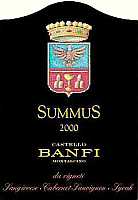
|
|
Sant'Antimo Summus 2000 |
|
| Castello Banfi (Italy) | |
| Grapes: Sangiovese (45%), Cabernet Sauvignon (45%), Syrah (15%) | |
| Price: € 35,00 | Score: |
| This wine shows a deep ruby red color and nuances of ruby red, little transparency. The nose reveals good personality with intense, clean, pleasing, refined and elegant aromas which start with good hints of plum jam, black cherry and blueberry followed by good aromas of blackberry, black currant, dried violet, cyclamen, licorice, tobacco, cocoa, cinnamon, vanilla and hints of menthol. In the mouth has good correspondence to the nose, a slightly tannic attack and however well balanced by alcohol, full body, intense flavors, good tannins. The finish is persistent with good flavors of black cherry, plum and blueberry. A well made wine. Summus ages for 23 months in cask. | |
| Food Match: Game, Braised and stewed meat, Hard cheese | |
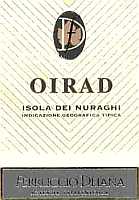
|
|
Oirad 2003 |
|
| Ferruccio Deiana (Italy) | |
| Grapes: Nasco, Moscato Bianco, Malvasia Bianca | |
| Price: € 16,50 - 375ml | Score: |
| This wine shows a brilliant amber yellow color and nuances of amber yellow, very transparent. The nose reveals intense, clean, pleasing, elegant and refined aromas which start with hints of dried fig, candied fruit and honey followed by aromas of dried apricot, chamomile, quince jam, date, litchi, almond and ripe peach. In the mouth has very good correspondence to the nose, a sweet and round attack however well balanced by alcohol, good body, intense flavors, pleasing sweetness. The finish is very persistent with flavors of dried apricot, litchi and honey. A well made wine. | |
| Food Match: Almond cakes, Hard and piquant cheese, Confectionery | |

|
|
Ajana 2000 |
|
| Ferruccio Deiana (Italy) | |
| Grapes: Cannonau (40%), Carignan (40%), Cabernet Sauvignon (20%) | |
| Price: € 27,00 | Score: |
| The wine shows an intense ruby red color and nuances of garnet red, little transparency. The nose reveals good personality with intense, clean, pleasing, elegant and refined aromas which start with hints of black cherry, plum and vanilla followed by aromas of raspberry, blueberry, blackberry, cyclamen, tobacco, dried violet and hints of black pepper. In the mouth has very good correspondence to the nose, a slightly tannic attack and however balanced by alcohol, good body, intense flavors, good tannins, round and agreeable. The finish is persistent with flavors of blackberry, plum and black cherry. A well made wine. Ajana ages for 18 months in barrique followed by 3 months in bottle. | |
| Food Match: Stewed and braised meat with mushrooms, Roasted meat, Hard cheese | |

|
|
Cortona Merlot Desiderio 2000 |
|
| Avignonesi (Italy) | |
| Grapes: Merlot (85%), Cabernet Sauvignon (15%) | |
| Price: € 37,00 | Score: |
| The wine shows an intense ruby red color and nuances of garnet red, little transparency. The nose reveals intense, clean, pleasing, refined and elegant aromas which start with hints of black cherry, blackberry and violet followed by aromas of blueberry, plum, black currant, tobacco, licorice, vanilla and pleasing hints of menthol. In the mouth has good correspondence to the nose, a slightly tannic attack and however well balanced by alcohol, full body, intense flavors, good tannins. The finish is persistent with flavors of black cherry, plum and blueberry. A well made wine. Desiderio ages for 18 months in barrique. | |
| Food Match: Game, Roasted meat, Braised and stewed meat, Hard cheese | |
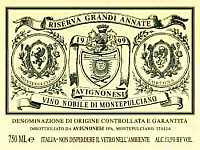
|
|
Vino Nobile di Montepulciano Riserva Grandi Annate 1999 |
|
| Avignonesi (Italy) | |
| Grapes: Prugnolo Gentile (85%), Cabernet Sauvignon (15%) | |
| Price: € 40,00 | Score: |
| This wine shows an intense ruby red color and nuances of garnet red, little transparency. The nose reveals good personality with intense, clean, pleasing, refined and elegant aromas which start with hints of blackberry, black cherry and blueberry followed by aromas of raspberry, cyclamen, violet, black currant, plum, licorice, pink pepper, vanilla and pleasing hints of chocolate. In the mouth has very good correspondence to the nose, a slightly tannic attack and however well balanced by alcohol, full body, intense flavors, good tannins. The finish is persistent with flavors of blackberry, black cherry and plum. A well made wine. This Nobile di Montepulciano ages for 30 months in barrique and in bottle for 6 months. | |
| Food Match: Game, Roasted meat, Braised and stewed meat, Hard cheese | |
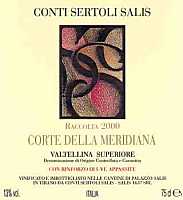
|
|
Valtellina Superiore Corte della Meridiana 2000 |
|
| Conti Sertoli Salis (Italy) | |
| Grapes: Nebbiolo (Chiavennasca) | |
| Price: € 17,00 | Score: |
| The wine shows a brilliant ruby red color and nuances of garnet red, moderate transparency. The nose reveals intense, clean, pleasing and refined aromas which start with hints of cherry and raspberry followed by aromas of plum, dried violet, dried rose, licorice, cyclamen, vanilla and hints of cinnamon. In the mouth has good correspondence to the nose, a slightly tannic attack and pleasing crispness, however balanced, good body, intense flavors, good tannins. The finish is persistent with flavors of plum and black cherry. This wine is produced with the technique of “rinforzo” (adding of must produced by dried grapes), ages for 18 months in cask and for at least 6 months in bottle. | |
| Food Match: Roasted meat, Game, Braised and stewed meat with mushrooms, Hard cheese | |

|
|
Sforzato di Valtellina Canua 2001 |
|
| Conti Sertoli Salis (Italy) | |
| Grapes: Nebbiolo (Chiavennasca) | |
| Price: € 28,80 | Score: |
| The wine shows a brilliant ruby red color and nuances of garnet red, moderate transparency. The nose reveals good personality with intense, clean, pleasing, refined and elegant aromas that start with hints of black cherry, plum and blackberry followed by aromas of raspberry, licorice, violet, dried rose, vanilla and cinnamon. In the mouth has good correspondence to the nose, a slightly tannic attack and pleasing crispness, however well balanced by alcohol, good body, intense flavors, good tannins. The finish is persistent with flavors of black cherry, raspberry and plum. A well made wine. This Sforzato ages for 24 months in cask and for at least 6 months in bottle. | |
| Food Match: Braised and stewed meat with mushrooms, Game, Roasted meat, Hard cheese | |
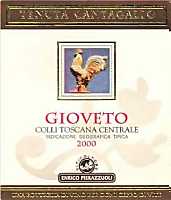
|
|
Gioveto 2000 |
|
| Tenuta Cantagallo (Italy) | |
| Grapes: Sangiovese (60%), Merlot (20%), Syrah (20%) | |
| Price: € 15,80 | Score: |
| The wine shows a deep ruby red color and nuances of garnet red, little transparency. The nose denotes intense, clean, pleasing, refined and elegant aromas that start with hints of black cherry jam and dried plum followed by aromas of blueberry jam, black currant, dried violet, licorice, tobacco, toasted wood, vanilla and hints of menthol, black pepper and clover. In the mouth has good correspondence to the nose, a slightly tannic attack and pleasing roundness, well balanced by alcohol, full body, intense flavors, good tannins, agreeable. The finish is persistent with good flavors of black cherry, plum and black currant. A well made wine. Gioveto ages for 10 months in barrique and for 10 months in bottle. | |
| Food Match: Game, Braised and stewed meat, Hard cheese | |
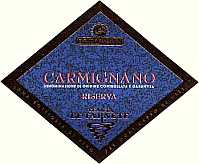
|
|
Carmignano Riserva 2000 |
|
| Tenuta Le Farnete (Italy) | |
| Grapes: Sangiovese (80%), Cabernet Sauvignon (20%) | |
| Price: € 19,80 | Score: |
| This wine shows an intense ruby red color and nuances of ruby red, little transparency. The nose reveals good personality with intense, clean, pleasing and refined aromas which start with hints of plum, black cherry and blackberry followed by aromas of bell pepper, violet, licorice, tobacco, vanilla and hints of menthol. In the mouth has good correspondence to the nose, a slightly tannic attack and however balanced, full body, intense flavors, good tannins. The finish is persistent with flavors of black cherry and plum. This wine ages for 24 months in barrique and for 12 months in bottle. | |
| Food Match: Game, Braised and stewed meat, Roasted meat, Hard cheese | |
Kellerei TerlanWith more than one hundred years of history, Kellerei Terlan, thanks to an attentive quality production, represents the tradition and history of the great wines of this territory |
|
In the Alto Adige, the famous Italian northern region known for the remarkable production of wines, between the cities of Bozen and Meran, there is the picturesque village of Terlan. In this place, placidly located in the center of the Adige valley, the production of wine has always represented the main agricultural activity and still now wines produced at Terlan are considered as a pearl of the enology in Alto Adige. In these suggestive places was established in 1893 Kellerei Terlan (Terlan Winery), with its more than one hundred years of history was also one of the very first cooperative wineries of Alto Adige, and the 24 founding producers of that time agreed on the goal of producing and promoting the selling of wine. Today the associated producers are about 100, the acreage of vineyards is of 150 hectares (370 acres) and the yearly production is of about 11,000 hectoliters (about 4,000 gallons) for a total of 1,2 millions of bottles. Its small size, such to make this winery to be considered among the smaller wine businesses of Alto Adige, greatly contributes to ensure a high quality of the wines produced every year.
In the modern rooms of Kellerei Terlan, managed by the technical experience of wine maker Hartmann Donà, are being produced and aged white wines, for the 50% of the total production, and red wines, for the remaining 50%. All the production, recognized as DOC (Denominazione d'Origine Controllata, Denomination of Controlled Origin), is divided into three qualitative lines clearly diversified. At Kellerei Terlan, besides producing wines, particular attention is paid to the historical memory as well. The winery owns a prestigious vinotheque in which are scrupulously kept and checked, bottles of wines of particular and favorable vintages. Kellerei Terlan today keeps 12,000 bottles of wines from 1955 to the most recent vintages, and they also have bottles of older vintages of which the oldest is dated back to the year of establishment. The important aspect of this precious and rare bottle vintage 1893, besides the historical one, is represented by its volume, 750 ml, just like the ones commonly used today, and this proves that since then - since the beginning - the winery was already aiming to high quality standards. This collection of wines, unique in the whole of Italy, is an authoritative witness of the enological tradition of Terlan where they have always made aged and longeval wines that with the passing of time they become more elegant and harmonious. In the Terlan area vine was cultivated since many centuries ago and vineyards, located in the valley and shielded by Tschöggelberg mountains, are situated at an altitude between 250 and 900 meters (820-2,950 feet), in particularly favorable conditions for the cultivation. The soil of Terlan is of porphyry type, with its typical red color and made of volcanic stones in which are found huge quantities of minerals, technically called quartz porphyry. The upper layer of the soil is sandy - therefore permeable and capable of accumulating heat - and characterized by a slightly acid Ph. The particular characteristics of the soil give Terlan wines good personality, moreover the high content in minerals, besides giving wines a particular mineral hint, contributes to the remarkable longevity of the wines produced in this area. The exposition of the vineyards towards south also ensures good conditions of insolation of about 1,800-2,100 hours per year. The average yearly temperature during the vegetative phase between May and September is of 12° C - 18° C (53-64° F), and the repetition of warm days and cool nights during the ripening period ensure good quantities of sugar and aromatic substances in the grapes.
The viticultural system adopted by Kellerei Terlan is the typical one found in Alto Adige - Pergola system - with a density from 3,500 and 6,000 vines per hectare. Since some years the vineyards are being converted into a wire-frame cultivation system - Guyot - in order to have densities from 5,000 and 8,000 vines per hectare. In order to favor the quality of wines, the yields of harvests have been reduced therefore allowing the vine to concentrate in few bunches a higher quantity of nutrients with the result of obtaining more bodied and concentrated wines. Another fundamental factor is represented by the choice of the more suitable varieties which will be planted in the most adequate positions. Kellerei Terlan makes use of its secular experience in cultivating vines in the most favorable positions and microclimates for every variety. The white berried grapes currently cultivated in the most lower and central areas are Pinot Blanc, Sauvignon Blanc and Chardonnay, in the higher areas is being cultivated Müller Thurgau, whereas in the lower and warmer areas are being cultivated Gewürztraminer and Pinot Gris. Among red berried grapes Pinot Noir is cultivated in the higher areas - between 450 and 650 meters (1475-2135 feet) - Schiava between 300 and 500 meters (985-1640 feet), whereas Lagrein, Cabernet Sauvignon and Merlot in the warmer and lower areas up to 350 meters (1150 feet). The wines of Kellerei Terlan are produced in order to respect and exalt the enological character of the region. Particular attention is paid to the time factor. Wine maker Hartmann Donà adopts criteria of slow aging, where wines stay on the fermented masses even for years before being transferred - with no hurry - in casks and bottles in order to complete the aging cycle. In this way it is intended to favor not only the development of the primary aromas in wines, but also and above all the secondary and tertiary ones, qualities which distinguish the territory of Terlan. Wines produced in particular and favorable vintages are even bottled after 10 years of aging therefore confirming the exceptional longevity and preservability of Terlan. According to the style, wines are being aged in containers of different types (stainless steel tanks, casks and barrels) and particular attention is paid to the temperature of fermentation and other factors such as the time of aging on the fermented mass and filtering practices. Kellerei Terlan's wines are currently produced in three qualitative and distinct lines: classics, regional and selections. The base of the production is represented by the classic line made of wines produced with all the typical white and red berried varieties of Alto Adige. These wines, generally produced in steel tanks, are released in the market relatively crisp and should preferably be consumed during their youth. Wines of the regional line are produced with wines cultivated in selected areas of Terlan. These wines, usually aged in cask and according to the many varieties, are distinguished for their character in which can be recognized the typicality of Terlan and are released in the market as soon as the right aging time in bottle has come. The best quality wines of Kellerei Terlan are the ones of the selected line. The grapes used for the production of these wines are cultivated according quality standards adopted by the winery, with yields of 56-70 quintals per hectare. Thanks to the aging done in barrels, these wines have good complexity, with rich aromas of fruit and particular elegance. Wines of the selected line can be recognized by the traditional bulb shaped bottle.
|
||||||||||||||||||||
|
Score legend Prices are to be considered as indicative. Prices may vary according to the country or the shop where wines are bought |
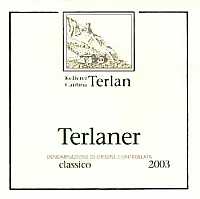
|
|
Alto Adige Terlano Bianco Classico 2003 |
|
| Cantina Terlano (Italy) | |
| Grapes: Pinot Blanc (60%), Chardonnay (20%), Sauvignon Blanc (20%) | |
| Price: € 6,00 | Score: |
| The wine shows a brilliant greenish yellow color and nuances of greenish yellow, very transparent. The nose denotes intense, clean and pleasing aromas which start with hints of peach, apple and pear followed by aromas of broom, litchi, banana and hints of mineral. In the mouth has good correspondence to the nose, a crisp attack and however balanced, intense flavors, delicate, pleasing. The finish is persistent with flavors of pear and peach. This wine ages for 6 months in steel tanks and a small part in cask. | |
| Food Match: Aperitifs, Dairy products, Eggs, Pasta and risotto with crustaceans and vegetables, Vegetables soups, Boiled fish | |
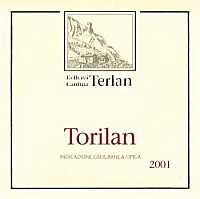
|
|
Torilan 2001 |
|
| Cantina Terlano (Italy) | |
| Grapes: Merlot (60%), Cabernet Sauvignon (25%), Pinot Noir (15%) | |
| Price: € 7,70 | Score: |
| The wine shows a brilliant ruby red color and nuances of garnet red, moderate transparency. The nose denotes intense, clean, pleasing and refined aromas which start with hints of raspberry, blackberry and black cherry followed by aromas of strawberry, blueberry, plum, violet and hints of vanilla. In the mouth has good correspondence to the nose, a slightly tannic attack and however balanced, good body, intense flavors, agreeable. The finish is persistent with flavors of raspberry, strawberry and black cherry. Torilan ages in cask for 16 months. | |
| Food Match: Broiled meat and barbecue, Roasted meat, Braised meat with mushrooms | |

|
|
Alto Adige Terlano Sauvignon Winkl 2003 |
|
| Cantina Terlano (Italy) | |
| Grapes: Sauvignon Blanc | |
| Price: € 8,40 | Score: |
| This wine shows an intense greenish yellow color and nuances of greenish yellow, very transparent. The nose reveals intense, clean, pleasing and refined aromas which start with hints of pear, peach and elder followed by aromas of nettle, pineapple, broom, sage, litchi and pleasing hints of mineral. In the mouth has good correspondence to the nose, a crisp attack and however balanced by alcohol, delicate, intense flavors, agreeable. The finish is persistent with flavors of peach, litchi and pear. This Sauvignon Blanc ages for 8 months in steel tanks. | |
| Food Match: Dairy products, Pasta and risotto with mushrooms and crustaceans, Vegetables soups | |
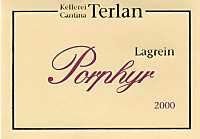
|
|
Alto Adige Lagrein Porphyr 2000 |
|
| Cantina Terlano (Italy) | |
| Grapes: Lagrein | |
| Price: € 20,80 | Score: |
| The wine shows a deep ruby red color and nuances of purple red, little transparency. The nose reveals good personality with intense, clean, pleasing and refined aromas which start with hints of black cherry, plum and blackberry followed by aromas of pomegranate, blueberry, violet, licorice, tobacco, vanilla, cocoa and hints of graphite. In the mouth has good correspondence to the nose, a slightly tannic attack and pleasing crispness, however well balanced by alcohol, full body, intense flavors, good tannins, agreeable. The finish is persistent with flavors of plum, black cherry and pomegranate. A well made wine. Porphyr ages in barrique. | |
| Food Match: Game, Roasted meat, Stewed and braised meat, Hard cheese | |
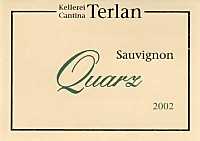
|
|
Alto Adige Terlano Sauvignon Quarz 2002 |
|
| Cantina Terlano (Italy) | |
| Grapes: Sauvignon Blanc | |
| Price: € 18,20 | Score: |
| The wine shows an intense greenish yellow color and nuances of greenish yellow, very transparent. The nose denotes good personality with intense, clean, pleasing, refined and elegant aromas which start with hints of passion fruit and peach followed by aromas of litchi, broom, mineral, elder, nettle, pineapple, bell pepper and sage. In the mouth has very good correspondence to the nose, a crisp attack and however balanced by alcohol, good body, intense flavors, pleasing. The finish is persistent with flavors of peach, litchi and passion fruit. A well made wine. Quarz ages for 8 months in cask. | |
| Food Match: Pesce arrosto, Zuppe di pesce e funghi, Pasta e risotti con pesce e crostacei | |
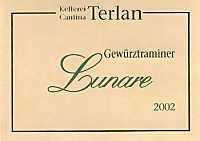
|
|
Alto Adige Gewürztraminer Lunare 2002 |
|
| Cantina Terlano (Italy) | |
| Grapes: Alto Adige Gewürztraminer Lunare 2002 | |
| Price: € 18,20 | Score: |
| This wine shows a brilliant golden yellow color and nuances of golden yellow, very transparent. The nose denotes good personality with intense, clean, pleasing, refined and elegant aromas which start with hints of grape, yellow rose, litchi and honey followed by aromas of apricot, broom, banana, pear, peach, sage and gooseberry. In the mouth has very good correspondence to the nose, a crisp attack and pleasing roundness, however well balanced, good body, intense flavors, agreeable. The finish is persistent with flavors of peach, apricot, litchi, honey and pear. A well made wine. Lunare ages for 12 months in cask. | |
| Food Match: Roasted fish, Roasted white meat, Pasta and risotto with fish and mushrooms | |
| Cantina Terlano - Silberleitenweg 7 - 39018 Terlan, Bozen (Italy) - Tel. +39 471 257135 Fax +39 471 256224 - Winemaker: Hartmann Donà - Established: 1893 - Production: 1.200.000 bottles - E-Mail: office@kellerei-terlan.com - WEB: www.kellerei-terlan.com |
Cellar Journal |
|
This section is reserved to wine producers who want to publish news and information about their business, to announce new products or just for communicating to its customers information and promotions about their products and activity. Send news to be published at our e-mail address.
|
News |
|
In this section will be published news and information about events concerning the world of wine and food. Whoever is interested in publishing this kind of information can send us a mail at our address.
|
Vine and GrapeThe small fruit of the vine is the fundamental element from which begins the amazing adventure of wine making, small colored berries producing the juice which originates endless styles of wine |
|
There are no sure and reliable evidences about the exact way it was possible to discover wine, and in particular, to the discovery of the events that from a small berry of grape, rich of sweet juice, it was possible to make a beverage very different from the original matter. The many cultures of the countries where wine is historically produced, believe the discovery of the beverage of Bacchus was because of a kind gift presented to the human kind by benevolent gods both for their joy and for their surviving. No matter the real origins of this millenary beverage, mythological or result of simple and revolutionary natural events, or even by the result of the accidental uncaring reserved to grape juice that with time got transformed because of fermentation, wine has always had a relevant place in the culture of the people in which it was present. It is amazing to know that everything originates by a “modest” and certainly tenacious plant - the vine - whose fruits, disposed in colored bunches, are rich of a sweet and properly acid juice capable of offering, after a series of extraordinary chemical modifications, a beverage of absolute value and importance: wine. Vine - the plant which bears the grape - belongs to the botanical family of Vitaceae, and of all the tens of members of this family, the genre vitis is the one having the highest importance for the production of wine. The most important of them is vitis vinifera - from which is made more than 99% of the wine produced in the world - and whose origins are from Europe and Central Eastern Asia. It is believed that the number of vitis vinifera varieties known all over the world is of some thousands. Vitis vinifera - despite it is the most common genre - it is not the only genre used for the production of wine. The other most common species suitable for the production of wine - although producing truly different results from the ones obtained by vitis vinifera - are vitis labrusca, vitis riparia and vitis rotundifolia, all originating from the American continent. These species however have a strategical and fundamental importance for the production of wine because they are, as opposed to vitis vinifera, resistant to the attacks of the devastating phylloxera. For this reason plants of vitis vinifera are grafted on rootstocks of American species - in particular vitis riparia - in order to contrast the devastating effects of this parasite.
|
|
The vine is a very robust and tenacious plant, with remarkable capacities of adaptation in many environmental and climatic conditions. Thanks to its adaptation capacities, the vine has widely spread in many countries of the world, in particular in those places with a tempered climate. Europe certainly is the continent where viticulture practiced in the aim of making wine is mainly present, followed by America, Africa, Oceania and then Asia. The adaptability of vine is pretty remarkable, in fact in certain places with cold climate - such as Champagne in France or Mosel and Rein in Germany - it is capable of surviving to strong frosts. Another “secret” which allows the vine to survive in “extreme” environmental and climatic conditions, in places that would be hostile to other plants, is represented by the tenacity and the high development of its roots. Vine's roots can reach a length of even six meters (about 20 feet) digging the soil and searching for precious water and nutrients necessary for its development and surviving.
The abundant quantity of leaves of the vine also contributes to the development and the surviving of this plant. Thanks to them the vine can do its functions of photosynthesis and to transform water and carbon dioxide naturally present in the air, by means of the light energy of the sun, into sugar, necessary both to the feeding of the plant and to the production of alcohol in wine. Hilly places generally represent the ideal environment for the cultivation of vine, both for the better drainage of water and for the sloping of soils which ensure a better incidence angle for sun rays and therefore a constant supplying of heat. The preference of cultivating vine in hills was already common and known since the very beginning of wine making, a practice witnessed also by the famous Virgil's phrase Bacchus amat collis (Bacchus loves hills). Hills also offer another advantage: the night cool air flows present in the bottom of valleys are warmed during the daytime and then go up to the slopes of hills and warm vineyards. Just like for every living organism, the biological and productive phases of the vine are regulated by events and phenomena which are repeated every year and that culminate with the bearing of fruits - the grape - that will be subsequently harvested. The productivity of the vine, as well as the quality of its fruits, obey to a biological cycle which evolves year after year. In the first three years of life, considered as its young age, vine is practically unproductive and it will be after this period of time the plant will enter an increasing productive phase. After the fourth or fifth year of age, the vine will begin to bear fruits suitable for the production of wine, however it will be in the age from twelve and twentyfive years that the highest quantitative production will be recorded. After twentyfive years the vine will progressively begin to diminish its productivity and harvests will therefore be lesser and lesser. For this reason some producers decide to replace their vineyards more than twentyfive years old with younger vines. Whether it is true that after this period vine begins to bear a lesser quantity of grape, it is also true that quality is considerably increased. The use of old vines forces a reduced production of grape, and therefore more management costs, with the result of a higher quality in wines and this is often a precise productive choice of many wineries. The many vegetative and productive phases of the vine are repeated every year and in every season take place specific events that will culminates with the ripening of the grape and therefore to the beginning of wine production. After harvesting and with the arrive of autumn, vine will have absorbed and stored a sufficient quantity of carbohydrates in the trunk and in leaves necessary to face the resting phase in which the plant survive while waiting for springtime and therefore resuming its vegetative cycle. The resuming of the vegetative activity is preceded by the so called “weeping of the vine” which signals the lymph - essential for the development of new sprouts - started to circulate again. The sprouting of buds usually takes place between March and April, whereas in the austral hemisphere takes place in September. The sprouting is also cause of the development of the leaves which will allow the resuming of photosynthesis and therefore the production of sugar and nutrients for the plant. After about 45-90 days - that in the boreal hemisphere takes place in the half of May and the end of June and in the austral hemisphere in the beginning of November and the half of December - begins the phase of blossoming. During this phase - which in the vine is pretty rapid - flowers blossom and free pollen that, by falling on the stigmas, allows fecundation. Not always fecundation is perfect and these cases in the berries of the grape there will be no development of pips, that is the seeds of the plant. After the fecundation berries will start to develop as a consequence of the increasing of the flower's ovary size. Flowers which was not fecundated dries and falls from the plant. In this phase the bunch begins to get its typical look and it will get developed in a pretty quick time: it is the beginning of the development of berries. In August - in the austral hemisphere in January - begins the ripening of berries which change their color - a phase called veraison - and from a green color they change to a green-yellow color for white berried grapes or red-blue for red berried grapes. Veraison takes place when inside the berry there is an increasing of a determined concentration of sugar and tartaric acid whereas tannins begins to hydrolyze. The beginning of veraison depends both by the climate and by the variety and signals the beginning of the ripening of berries. During the ripening phase, the berries grows up in size because of the increasing quantity of sugar, water and other components (including polyphenols, mineral elements and aminoacids) whereas acidity will progressively begins to diminish, the skins gets less thick and the pulp softer. This phase is pretty critical for the production of wine because it must be decided the right moment at which grape is ripe and therefore proceeding with the harvest. For this reason it is periodically measured - frequently every day - the quantity of sugar and acid in the juice - and for red berried grapes the level of polyphenols ripeness is measured as well - in order to decide the exact moment in which starting the harvest. Deciding the right quantity of sugar and acid in the grape is fundamental according to the style of wine to be made and according to the variety of grape. High quantities of sugar - condition which is ensured by ripeness and allows a higher production of alcohol - mean a lower quantity of acid and therefore a flabby wine. On the other hand, high quantities of acid - a condition ensured by underripe or not perfectly ripe grapes - allow the production of more crisp wines while having a lesser quantity of sugar and therefore a lower production of alcohol. After harvesting, the vine enters the resting phase again and the cycle repeats.
|
||||||||||||
|
The grape is the fruit of the vine and it develops in bunches as a consequence of the fecundation of flowers. The grape berry is fixed to the stem and this part, because of the substances contained in it and that would negatively affect the taste of wine, is eliminated before pressing the grape by means of a process called destemming. The grape berry's appearance is usually round or stretched and it is covered by the skin whose thickness varies according to each variety and it can also represent 10% of its weight. The skin is rich in pectin, cellulose, aromatic substances and polyphenolic components - generally defined as tannins - responsible for the color in red wines, as well as for the structure and astringency. Both aromatic substances and polyphenols contained in the skin can be extracted by means of maceration in the must - the grape juice produced by pressing - and the quantity of extraction is proportional to the time of maceration. These polyphenols are soluble in alcohol - which is produced during the fermentation of must - and in a lesser extent, in water as well. For this reason the skins of red berried grapes are being macerated in the must with the explicit purpose of giving color to red wines and to extract aromas and tannins. Grape juice, both of white berried species and red berried species, has a greenish yellow color, therefore in case the maceration of the skin in the must is completely avoided, it is possible to obtain white wines with red grapes, such as in case of many classic method sparkling wines produced with Pinot Noir. Likewise, a short maceration of the skins - usually of few hours - can be used for the production of rose wines with red berried grapes. It should be however considered that the quantity of colorant substances contained in the skin of red berries grapes is different according to each variety and therefore every red grape will have proper colorant capacities and qualities. The skin of the grape is covered by a waxy like substance - which can be easily observed in red berried grapes for its whitish color - on which can also be present yeasts, naturally present in the air, that will start alcoholic fermentation as they will get in contact with the juice. The pulp of the grape berry is rich in water, sugar - present in variable quantities between 15% and 25% of the total matter - acid, pectin, mineral elements, vitamins and nitrogenous substances. The concentration of these elements varies according to the inside zone of the berry.
By observing a cross section of a grape berry, they can be individuated three distinct zones in which the pulp has different consistencies and concentrations of substances whose quantity varies according to the ripeness level (Figure ). The area which is just under the skin - the external part - is rich in tannins and aromatic substances, contains about 30% of sugar and about 20% of acids. In the middle part it is found the highest concentration of sugar - about 40% - and about 30% of acids. In the inner part are found pips and here is also found the highest concentration of acids - about 50% - and about 30% of sugar. Pips are rich in polyphenols - of pretty astringent nature - that will be extracted during the pressing of berries and that will get mixed to the must. In pips are also found fatty substances that can be used for the production of oil. As a consequence of the pressing of the berries it is obtained the must which is made of many liquid and solid substances present in the many zones of the pulp and of the skin. Water is the fundamental element and represent about 70-80% of the must, sugar for 15-30%, acids for 0.5-1.5% and other substances such as minerals, vitamins, polyphenols, aromatic components, pectin, nitrogenous substances, enzymes and microorganisms (yeasts, bacteria and molds). The main sugars of the must are fructose and glucose. Every gram of sugar contained in the must produces - because of the fermentation - about 0.67 grams of alcohol and therefore by measuring the quantity of sugar in the must it is possible to assess the alcoholic percentage in the wine at the end of fermentation. For example, in case a liter of must contains 20 grams of sugar, the alcoholic percentage in the wine will be of about 13.4% (20 × 0.67 = 13.4). The most important acids present in the must are tartaric acid, malic acid and citric acid. Tartaric acid - typical in the grape - certainly is the most important one and it is present in the highest percentage in relation to the others. Polyphenols - usually called tannins and present in variable quantities and according to many factors including climate, environment, grape variety and wine making practices - are responsible for the taste of wine as well as for the color and astringency in red wines. Among the most important polyphenols components are mentioned anthocyanins, responsible for the color in red wines, and flavones, which play an important role in the color of white wines.
|
||||||||
ArmagnacThe most ancient wine brandy of France it is the result of the distillation of selected white wines produced in the Gascony region |
|
The region in which Armagnac is produced is located in the South-West part of France in an area known as Gascony, the region of Musketeers. The area includes three departments: “Gers”, a part of “Lot et Garonne” and an area of“Landes”. In this area are found many rivers and the two most important ones are Adour and Garonne. The territory of Armagnac, having an area of 10,500 hectares (about 26,000 acres), is divided into three regions: Ténarèze (5,200 hectares, 12,800 acres), Bas-Armagnac (5,130 hectares, 12,650 acres) and Haut-Armagnac (160 hectares, 400 acres), each one of them having peculiar characteristics according to the geological formation, as the type of soil greatly influences the value and the character of the brandy. As opposed to Cognac, which gets its finesse and value thanks to soils rich in limestone, Armagnac gives its best in siliceous soils. Ténarèze is characterized by not very accentuated peaks, in other words placid hills covered by vineyards and woods. Haut-Armagnac is an area in which are found low sloped hills divided in characteristic valley asymmetrically disposed which give the view a typical aspect. Bas-Armagnac is characterized by placid and smooth slopes where at the base are found cultivation of grains, in the middle vineyards find their ideal habitat, whereas the tips are covered by oak woods.
|
|
It seems Armagnac is the most ancient wine brandy of the world. Maybe it is not the noblest one but according to its history and its origins, it seems to be one of the most charming and mysterious brandies. Armagnac was very renowned since the Middle Age for its therapeutic qualities, it will then become a brandy of common consumption. Researches done in libraries have allowed the discovery of a document dated back to 1411 which tells about a man, whose name was Antoine, who became famous in Toulouse because he was a talented wine distiller, as well as for his Aygue ardente or aygordent (burning water). In a manuscript written in Gascony dialect and dated back to the same year, known as Manuscript of Auch, are being described the many ways and the possible use of wine brandies: it is the first document which clearly refer to the consumption and the “side” effects described as “…it gives vivacity to the mind and cheerfulness…”. At Toulouse in 1430 became famous Mr. and Mrs. Nouvel for their skill in distillating wine and for the quality of their brandies. In 1431, in a document about the heritage of Count Vic-Fezensac, they were mentioned “barrels” and a “press” therefore evidencing the importance of wood casks and in particular their effects in the aging of a distillate. In 1461 brandies were just one of the many goods traded in the market of Saint-Séver, however, besides being an exchange good, they were also subjected to taxes.
The exact date of the origin of Armagnac is not easily definable, but it is however clear that it is earlier than Cognac - which was created for the first time around 1600 - and even then Whisky, which was mentioned for the first time in a written document around 1494. Since Roman times the people of Gascony have always paid attention to the cultivation of vine, and the products of this territory were also appreciated abroad. In the twelfth century Gascony viticulturists began commercial relationships with English and Dutch. At those times the trading routes were few as well as scarcely safe and goods were transported through rivers, anyway transporting wine was always risky, not because of the risk of robberies or mercenary acts, indeed for its tendency to deteriorate. A distilled product ensured a higher reliability and longevity and the guarantee of a preemptive profit. In the beginning of the seventeenth century Dutch owned the most powerful commercial fleet of the world and they traveled in the neighboring coasts and territories in search for business. They had countless businesses with French viticulturists and in particular with Armagnac producers, because the product had a volume lower than four fifths than wine, it was less susceptible to spoilage, and therefore Dutch merchants traded lots of Armagnac destined to the consumption in Netherlands as well as, after some slight processing, to be exported in other countries of Northern Europe. This “processing” consisted in adding some brandy to wines in order to raise the alcoholic percentage, both because they were more resistant to transportation, that is less sensible to spoilage, but also because consumers of Northern Europe preferred wines with pretty high alcoholic percentages. In order to have an idea of the notoriety of Armagnac it is enough to observe the development of the vineyard acreage in the Gers area: in 1804 the acreage destined to the cultivation of vine was 72 hectares (177 acres), in 1850 was 96,000 hectares (237,000 acres) and in 1872 was 100,000 hectares (247,000 acres) with a production of 100,000 hectoliters of alcohol (more than 2,6 millions of gallons). Some years later phylloxera struck the territory of Armagnac destroying vineyards and strongly compromising an economy based on vine and its derivatives. Farmers who was severely damaged by this flagellum, not having proper resources in order to proceed with the necessary and expensive replanting, were subject of a severe diminution of the production that in 1937 was just 5,000 hectoliters (132,000 gallons) also because of the bad meteorological conditions. At the vigil of the World War II - in 1939 - they were only produced 22,000 hectoliters of alcohol (581,000 gallons) and the cultivated acreage was just 53,000 hectares (131,000 acres). The grave crisis which took place in the Armagnac region was slowly recovered and today vineyards have an acreage of 28,000 hectares (69,200 acres) of which 15,000 (37,000 acres) reserved to the production of wines destined to distillation. The current average yearly production is of about 50,000 hectoliters of Armagnac (1,3 millions of gallons) which is commercialized in more than 130 countries in the world.
|
||||||||
|
A decree of 1909 has delimited the production area and recognizes the appellation “Armagnac” in three production areas corresponding to the three “crus”: Bas-Armagnac, Ténarèze and Haut Armagnac, three areas with peculiar characteristics and that give origin to three different products.
Before discussing the method used for the production of Armagnac, it is necessary to know its raw matter - the grape - as well as the climate and the territory which represent the fundamental element of a brandy. The quality of a brandy like the Armagnac is created and developed during the fermentation, for this reason the most suitable grapes must have little aromas in order not to cover the aromas of fermentation. Ideal grapes are the ones producing wines with low percentages of alcohol and high acidity. The grapes set by the disciplinary of 1936 are Folle Blanche, Jaune, Picpoul, Saint-Emilion, Colombard, Jurançon, Blanquette, Mauzac, Clairette, Mesliers and Baco 22 A. The main grape is Saint-Emilion, also known as Ugni Blanc - original of Italy where it is known as Trebbiano Toscano - also used for the production of Cognac. Besides Saint-Emilion the other main grapes are Folle Blanche and Colombard. It is useful to know that some producers separately distillate and age these varieties with truly interesting results. The alembic still used for the production of this brandy is called “Armagnacais”, built with copper because it is resistant to the acids of wine. It is a continuous distillation alembic still and the brandy is distilled just once. The wine to be distilled, before entering the boiler is used to cool down the steam produced by the boiler, in this way the wine enters the alembic still preheated. Thanks to his experience, the master distiller, who have to carefully know his alembic still, checks all the phases of the distillation process from the beginning to the end. It is by means of the management of the heat, of the flowing of wine into the boiler, the percentage of alcohol of the resulting brandy, which can be obtained a good quality distillate. From the result of the distillation is obtained a brandy having 58-63% of alcohol. Recently the traditional alembic stills have been replaced by double distillation alembic stills, the traditional “Charentais” used for the production of Cognac. This event has divided in two sides experts and Armagnac lovers. The two methods are not the same and, of course, give origin to different products. The traditional alembic still is more suitable for high quality wines, because it produces a distillate rich in substances which need a proper aging time. The use of Charentais alembic still satisfies the commercial and market needs, the necessity of products with a pretty rapid aging time and the taste of consumers who demand lighter and easy drinking products. From the double distillation process is obtained a brandy having 70% of alcohol. The most frequent denominations are “Armagnac” and “Bas-Armagnac”. A bottle belonging to the “Armagnac” denomination can contain brandies coming from one or more crus of the region, whereas a bottle of “Bas-Armagnac” exclusively contains brandy coming from this area and it is considered as the best. According to the disciplinary, in a bottle of Armagnac must be clearly mentioned the address of the producer. The Armagnac destined to commercialization must have 40% of alcohol. Generally the label does not mention any vintage, however Armagnac cannot be commercialized in case it was aged for less than one year. The age of Armagnac can be recognized by means of the following designations:
Moreover there can be found bottles of Armagnac with the indication of 10, 20 and 25 years of aging mentioned in the label, however the age must be referred to the younger brandy. Armagnac can also be millesimée - the year referred to the distillation - and it must be made with blends produced in the very same year mentioned in the label.
|
||||
|
The aging period greatly affects Armagnac also thanks to the staying in 400 liters casks (105 gallons) constructed with the oak coming from the forests of Gascony and Limousin. Wood is important because passes its essences to the distillate and many are the characteristics that a distillate gets from the cask in which it is being aged. Among the many are mentioned tannins which are responsible for the changing of the color of Armagnac. Lignin, by get mixed with alcohol, produces many aromatic substances that will substantially affect the distillate. Just like for Cognac the part of distillate which evaporates from casks is called “the part of angels”. Even time represents an important factor. During the first 3 years, the distillate changes its original color into straw yellow and the flavors are affected by tannins which are still too harsh. This is a period in which Armagnac is to be scrupulously controlled in order to avoid it to get the so called “wood disease”, that is when the distillate has absorbed too much tannin and gets an unpleasing and bitter taste. Armagnac begins its “adult” phase after three years of aging and up to ten years. In this phase the substances passed from wood are slowly transformed, the bitter taste of young tannins begins to attenuate, the aromas begin to be characterized by hints of flowers and fruits, the color changes from straw yellow to golden yellow. After 10 years, and up to 40 years, Armagnac continues its transformation, the color darkens and chemical processes continue to refine and age the brandy. In this phase the aroma of plum is particularly emphasized and the Armagnac is at the top of its life cycle. After 40 years begins the decline, the color gets darker, up to getting a dark brown color, the taste attenuates and gets sweeter as the old age favors the transformation of some substances contained in sugar. During youth the casks are moved in a place of the cellar - usually under the roof - in which are found huge variation of temperature in order to accentuate the exchange between the inside and the outside environment of the cask. As time passes by, that is when the brandy needs stability and regularity, the casks are moved in lower rooms, therefore in places where temperature and humidity are constant. The expert cellar master continuously controls the Armagnac in order to decide the right time for transferring the distillate from a young cask, which passes substances to the distillate, to an older cask, which has already passed all its tannins and favors a more stable aging. After 6-12 months of staying in a new cask, the distillate is generally transferred in an old cask in order to favor aging. When the cellar master thinks the right time has come, he proceeds with the blending of the distillate in order to create the many crus. When the Armagnac is mature, it is being transferred in oak containers having a volume of 10,000 liters (about 2,650 gallons), where the influences of wood are minimal and the transformations are slower. Older Armagnacs, in order to avoid spoilage, are transferred in glass containers which ensure a good keeping of the organoleptic qualities. Before being commercialized it is necessary to lower the alcoholic percentage of Armagnac. This operation consists in lowering the alcoholic percentage down to 40% and it is obtained by adding - about every 2 months - small quantities of petites eaux, that is a mixture of young brandies with 20% of alcohol and plain water.
|
|
At room temperature, fill for 1/3 of its capacity a not very large “balloon' shaped glass. The glass should be held for its base and rotated in order to favor oxygenation, then, in short repetitions, the glass will be moved under the nose in order to appreciate aromas while taking some breaks in order not to accustom the olfactory system. Armagnac is to be drunk in little and repeated sips in order to taste all the sensations the distillate is capable of evoking. Some prefer to hold the glass on the palm of the hand in order to warm the distillate and favor the development of all the aromatic substances. A good Armagnac is generally enjoyed and tasted at the end of meals and countless are the cocktails in which is used as an ingredient.
|
Wine Parade |
|
|
| The best 15 wines according to DiWineTaste's readers. To express your best three wines send us an E-mail or fill in the form available at our WEB site. |
| Rank | Wine, Producer | |
|---|---|---|
| 1 |
| Turriga 1998, Argiolas (Italy) |
| 2 |
| Alto Adige Gewürztraminer Kolbenhof 2002, Hofstätter (Italy) |
| 3 |
| Amarone della Valpolicella Classico Capitel Monte Olmi 1999, Tedeschi (Italy) |
| 4 |
| Margaux 2000, Ségla (France) |
| 5 |
| Franciacorta Cuvée Annamaria Clementi 1996, Ca' del Bosco (Italy) |
| 6 |
| Anjou 2001, Domaine de Montgilet (France) |
| 7 |
| Syrah Winemaker's Lot Vic 3, Concha y Toro (Chile) |
| 8 |
| Rioja Reserva Era Costana 1999, Bodegas Ondarre (Spain) |
| 9 |
| Barolo Cicala 1999, Poderi Aldo Conterno (Italy) |
| 10 |
| Fumé Blanc Napa Valley 2001, Grgich Hills (USA) |
| 11 |
| Riesling Cuvée Frédéric Emile 1999, Maison Trimbach (France) |
| 12 |
| Brunello di Montalcino Prime Donne 1998, Donatella Cinelli Colombini (Italy) |
| 13 |
| Aglianico del Vulture La Firma 2000, Cantine del Notaio (Italy) |
| 14 |
| Harmonium 2001, Firriato (Italy) |
| 15 |
| Barolo Brunate 1999, Enzo Boglietti (Italy) |
| |||||||
Privacy Policy | |||||||


| Copyright © 2002-2024 Antonello Biancalana, DiWineTaste - All rights reserved |
| All rights reserved under international copyright conventions. No part of this publication and of this WEB site may be
reproduced or utilized in any form or by any means, electronic or mechanical, without permission in writing from DiWineTaste. |